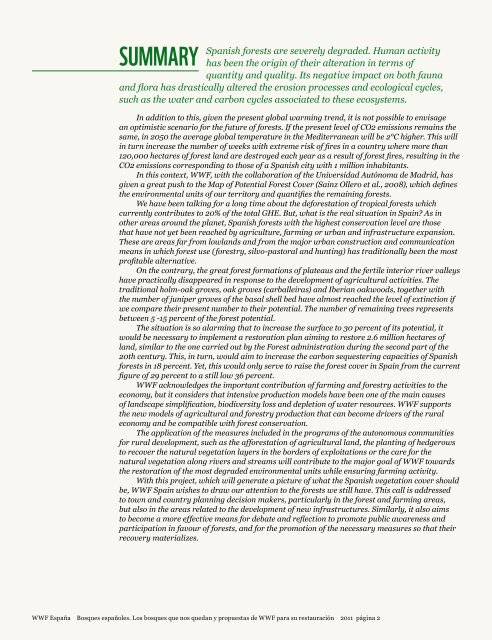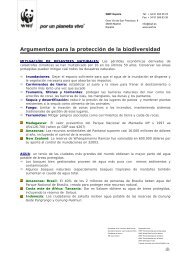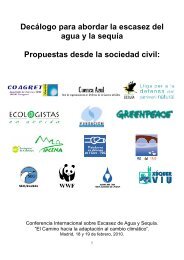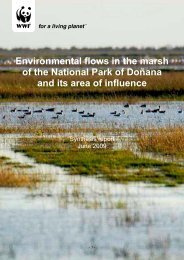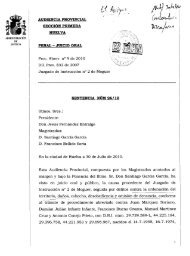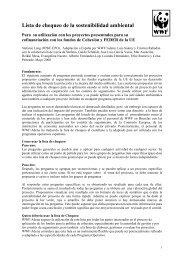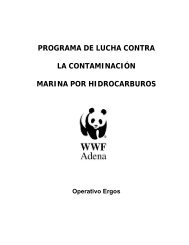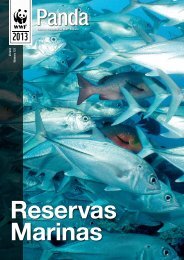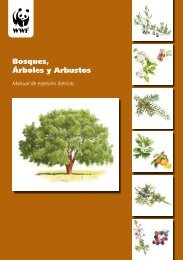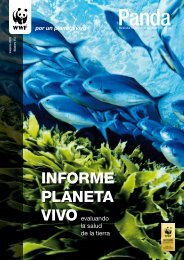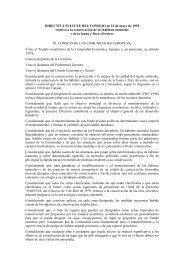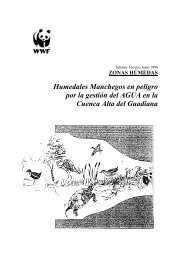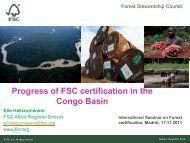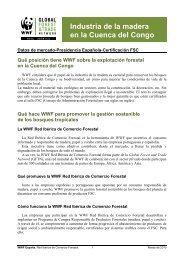SUMMARYSpanish forests are severely <strong>de</strong>gra<strong>de</strong>d. Human activityhas been the origin of their alteration in terms ofquantity and quality. Its negative impact on both faunaand flora has drastically altered the erosion processes and ecological cycles,<strong>su</strong>ch as the water and carbon cycles associated to these ecosystems.In addition to this, given the present global warming trend, it is not possible to envisagean optimistic scenario for the future of forests. If the present level of CO2 emissions remains thesame, in 2050 the average global temperature in the Mediterranean will be 2°C higher. This willin turn increase the number of weeks with extreme risk of fires in a country where more than120,000 hectares of forest land are <strong>de</strong>stroyed each year as a re<strong>su</strong>lt of forest fires, re<strong>su</strong>lting in theCO2 emissions corresponding to those of a Spanish city with 1 million inhabitants.In this context, <strong>WWF</strong>, with the collaboration of the Universidad Autónoma <strong>de</strong> Madrid, hasgiven a great push to the Map of Potential Forest Cover (Sainz Ollero et al., 2008), which <strong>de</strong>finesthe environmental units of our territory and quantifies the remaining forests.We have been talking for a long time about the <strong>de</strong>forestation of tropical forests whichcurrently contributes to 20% of the total GHE. But, what is the real situation in Spain? As inother areas around the planet, Spanish forests with the highest conservation level are thosethat have not yet been reached by agriculture, farming or urban and infrastructure expansion.These are areas far from lowlands and from the major urban construction and communicationmeans in which forest use (forestry, silvo-pastoral and hunting) has traditionally been the mostprofitable alternative.On the contrary, the great forest formations of plateaus and the fertile interior river valleyshave practically disappeared in response to the <strong>de</strong>velopment of agricultural activities. Thetraditional holm-oak groves, oak groves (carballeiras) and Iberian oakwoods, together withthe number of juniper groves of the basal shell bed have almost reached the level of extinction ifwe compare their present number to their potential. The number of remaining trees representsbetween 5 -15 percent of the forest potential.The situation is so alarming that to increase the <strong>su</strong>rface to 30 percent of its potential, itwould be necessary to implement a restoration plan aiming to restore 2.6 million hectares ofland, similar to the one carried out by the Forest administration during the second part of the20th century. This, in turn, would aim to increase the carbon se<strong>que</strong>stering capacities of Spanishforests in 18 percent. Yet, this would only serve to raise the forest cover in Spain from the currentfigure of 29 percent to a still low 36 percent.<strong>WWF</strong> acknowledges the important contribution of farming and forestry activities to theeconomy, but it consi<strong>de</strong>rs that intensive production mo<strong>de</strong>ls have been one of the main causesof landscape simplification, biodiversity loss and <strong>de</strong>pletion of water resources. <strong>WWF</strong> <strong>su</strong>pportsthe new mo<strong>de</strong>ls of agricultural and forestry production that can become drivers of the ruraleconomy and be compatible with forest conservation.The application of the mea<strong>su</strong>res inclu<strong>de</strong>d in the programs of the autonomous communitiesfor rural <strong>de</strong>velopment, <strong>su</strong>ch as the afforestation of agricultural land, the planting of hedgerowsto recover the natural vegetation layers in the bor<strong>de</strong>rs of exploitations or the care for thenatural vegetation along rivers and streams will contribute to the major goal of <strong>WWF</strong> towardsthe restoration of the most <strong>de</strong>gra<strong>de</strong>d environmental units while en<strong>su</strong>ring farming activity.With this project, which will generate a picture of what the Spanish vegetation cover shouldbe, <strong>WWF</strong> Spain wishes to draw our attention to the forests we still have. This call is addressedto town and country planning <strong>de</strong>cision makers, particularly in the forest and farming areas,but also in the areas related to the <strong>de</strong>velopment of new infrastructures. Similarly, it also aimsto become a more effective means for <strong>de</strong>bate and reflection to promote public awareness andparticipation in favour of forests, and for the promotion of the necessary mea<strong>su</strong>res so that theirrecovery materializes.<strong>WWF</strong> España Bos<strong>que</strong>s españoles. <strong>Los</strong> <strong>bos<strong>que</strong>s</strong> <strong>que</strong> <strong>nos</strong> <strong>que</strong>dan y <strong>propuestas</strong> <strong>de</strong> <strong>WWF</strong> <strong>para</strong> <strong>su</strong> restauración 2011 página 2
RESUMEN<strong>Los</strong> <strong>bos<strong>que</strong>s</strong> españoles están muy <strong>de</strong>gradados. Laactividad <strong>de</strong>l ser humano los ha alterado en cantidady calidad: ha impactado negativamente sobre lafauna y la flora, ha agravado los procesos erosivos y ha alterado los ciclosecológicos, como el hídrico o el <strong>de</strong>l carbono, asociados a estos ecosistemas.Una situación <strong>que</strong>, añadida al actual contexto <strong>de</strong> calentamiento global, <strong>nos</strong> impi<strong>de</strong> dibujarun escenario optimista <strong>para</strong> el futuro <strong>de</strong> los <strong>bos<strong>que</strong>s</strong>. De mantenerse la ten<strong>de</strong>ncia actual <strong>de</strong>emisiones <strong>de</strong> CO2, en 2050 la temperatura media en el Mediterráneo habrá aumentado 2ºC. Estoincrementará las semanas <strong>de</strong> riesgo extremo <strong>de</strong> incendios en un país en el <strong>que</strong> anualmente ar<strong>de</strong>nunas 120.000 hectáreas <strong>de</strong> <strong>su</strong>perficie forestal, lo <strong>que</strong> <strong>su</strong>pone una emisión a la atmósfera <strong>de</strong> tantoCO2 al año como el <strong>que</strong> emite una ciudad española <strong>de</strong> un millón <strong>de</strong> habitantes.En este contexto <strong>WWF</strong>, en colaboración con la Universidad Autónoma <strong>de</strong> Madrid, haimpulsado el Mapa <strong>de</strong> Paisajes Vegetales Potenciales (Sainz Ollero et al., 2008), en el <strong>que</strong> se<strong>de</strong>finen las unida<strong>de</strong>s ambientales <strong>de</strong> nuestro territorio y se cuantifican los <strong>bos<strong>que</strong>s</strong> <strong>que</strong> <strong>nos</strong><strong>que</strong>dan.Durante mucho tiempo hemos hablado <strong>de</strong> la <strong>de</strong>forestación <strong>de</strong> los <strong>bos<strong>que</strong>s</strong> tropicales, <strong>que</strong> enla actualidad provoca el 20% <strong>de</strong>l total <strong>de</strong> gases <strong>de</strong> efecto inverna<strong>de</strong>ro <strong>que</strong> se emiten a la atmósfera,pero ¿qué <strong>su</strong>ce<strong>de</strong> en España? Al igual <strong>que</strong> esos rincones <strong>de</strong>l planeta, los <strong>bos<strong>que</strong>s</strong> españolesmejor conservados son los <strong>que</strong> se ubican don<strong>de</strong> la agricultura, la gana<strong>de</strong>ría o la expansiónurbanística y <strong>de</strong> infraestructuras no han llegado. Se trata <strong>de</strong> zonas alejadas <strong>de</strong> las llanuras y <strong>de</strong>las principales construcciones urbanas y <strong>su</strong>s vías <strong>de</strong> comunicación, en las <strong>que</strong> el uso forestal(selvícola, silvo-pastoral o cinegético) ha sido tradicionalmente la opción económica más rentable.Por el contrario, las gran<strong>de</strong>s formaciones boscosas <strong>de</strong> las mesetas y <strong>de</strong> los fértiles valles fluvialesinteriores prácticamente han <strong>de</strong>saparecido a expensas <strong>de</strong>l <strong>de</strong>sarrollo <strong>de</strong> las activida<strong>de</strong>s agrarias.<strong>Los</strong> carrascales, las carballeiras y los robledales ibéricos, junto a las formaciones canarias<strong>de</strong> sabinares <strong>de</strong>l piso basal, se encuentran casi en extinción si com<strong>para</strong>mos <strong>su</strong> extensión actualcon <strong>su</strong> potencialidad. De estas formaciones apenas <strong>nos</strong> <strong>que</strong>da entre el 5 y el 15 por ciento <strong>de</strong><strong>su</strong> <strong>su</strong>perficie potencial. Su situación es tan dramática <strong>que</strong>, <strong>para</strong> elevar <strong>su</strong> <strong>su</strong>perficie hasta unvalor <strong>de</strong>l 30% con relación a <strong>su</strong> potencial, sería necesario restaurar más <strong>de</strong> 2,6 millones <strong>de</strong>hectáreas a través <strong>de</strong> un plan <strong>de</strong> restauración <strong>de</strong> una magnitud equivalente al emprendido porla Administración forestal en la segunda mitad <strong>de</strong>l siglo XX, lo <strong>que</strong> a <strong>su</strong> vez incrementaría lacapacidad <strong>de</strong> fijación <strong>de</strong> CO2 <strong>de</strong> los <strong>bos<strong>que</strong>s</strong> españoles en un 18%. Aún así, esta cifra sólo serviría<strong>para</strong> elevar la cobertura arbórea en España <strong>de</strong>l actual 29% a un todavía escaso 36 por ciento.<strong>WWF</strong> reconoce la importancia <strong>de</strong> las activida<strong>de</strong>s agrarias y forestales en la economía, peroconsi<strong>de</strong>ra <strong>que</strong> los mo<strong>de</strong>los <strong>de</strong> producción intensiva han sido una <strong>de</strong> las principales causas <strong>de</strong> lasimplificación <strong>de</strong>l paisaje y <strong>de</strong> la pérdida <strong>de</strong> biodiversidad y <strong>de</strong> recursos hídricos. <strong>WWF</strong> apuestapor el impulso <strong>de</strong> nuevos mo<strong>de</strong>los <strong>de</strong> producción agraria y forestal <strong>que</strong> puedan ser motores <strong>de</strong> laeconomía rural <strong>de</strong> forma compatible con la conservación <strong>de</strong> los <strong>bos<strong>que</strong>s</strong>.La aplicación <strong>de</strong> las medidas contempladas en los programas autonómicos <strong>de</strong> <strong>de</strong>sarrollorural, como la forestación <strong>de</strong> tierras agrícolas, la creación <strong>de</strong> setos vivos <strong>para</strong> recuperarvegetación natural en las lin<strong>de</strong>s <strong>de</strong> las explotaciones o el cuidado <strong>de</strong> la vegetación <strong>de</strong> ribera <strong>de</strong>ríos y arroyos, contribuiría al objetivo <strong>de</strong> <strong>WWF</strong> <strong>de</strong> restaurar las unida<strong>de</strong>s paisajísticas más<strong>de</strong>gradadas, a la vez <strong>que</strong> se aseguraría la actividad agraria.Con este trabajo, a través <strong>de</strong> una fotografía <strong>de</strong> lo <strong>que</strong> <strong>de</strong>bería ser el espacio vegetal español,<strong>WWF</strong> España quiere hacer un llamamiento sobre los <strong>bos<strong>que</strong>s</strong> <strong>que</strong> <strong>nos</strong> <strong>que</strong>dan. Está dirigido a los<strong>que</strong> toman las <strong>de</strong>cisiones sobre la or<strong>de</strong>nación <strong>de</strong>l territorio, en especial el forestal y agrario, perotambién el relacionado con el <strong>de</strong>sarrollo <strong>de</strong> nuevas infraestructuras. De la misma forma, preten<strong>de</strong>ofrecer un documento <strong>de</strong> <strong>de</strong>bate y reflexión <strong>que</strong> fomente la sensibilización y participación públicaa favor <strong>de</strong> los <strong>bos<strong>que</strong>s</strong> e impulse las medidas necesarias <strong>para</strong> <strong>que</strong> <strong>su</strong> recuperación se convierta enuna realidad.<strong>WWF</strong> España Bos<strong>que</strong>s españoles. <strong>Los</strong> <strong>bos<strong>que</strong>s</strong> <strong>que</strong> <strong>nos</strong> <strong>que</strong>dan y <strong>propuestas</strong> <strong>de</strong> <strong>WWF</strong> <strong>para</strong> <strong>su</strong> restauración 2011 página 3


